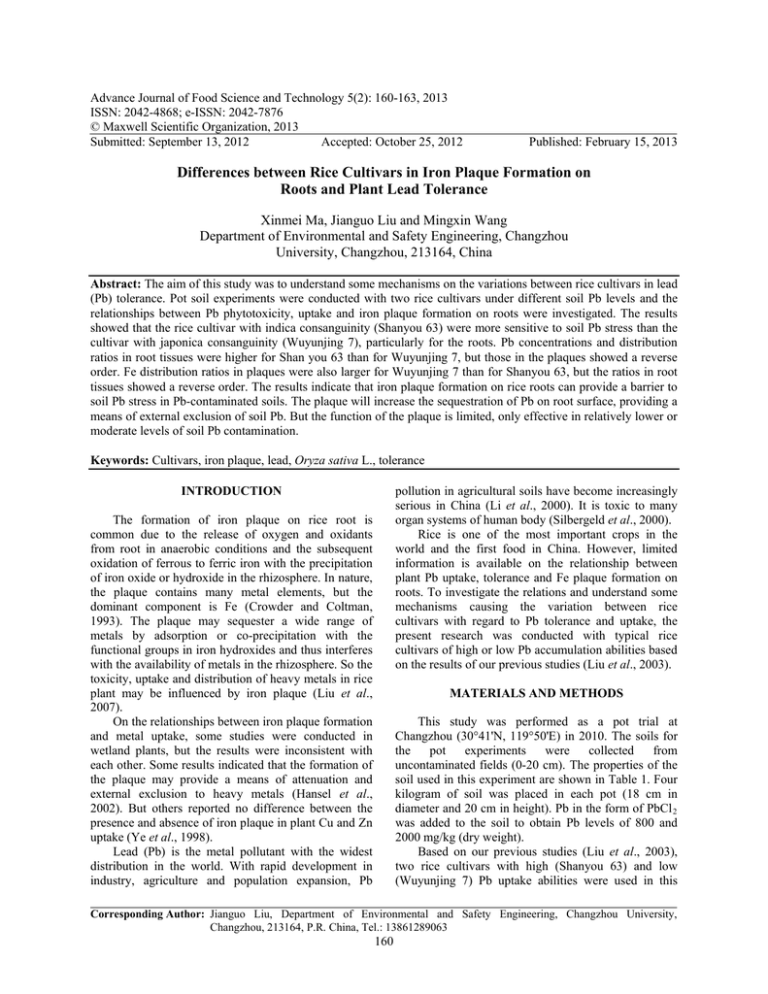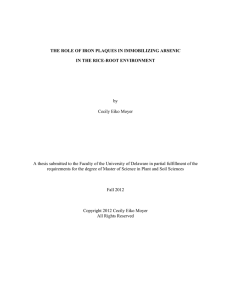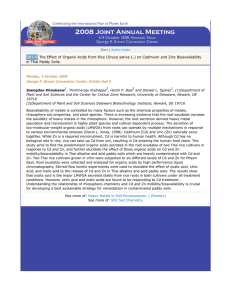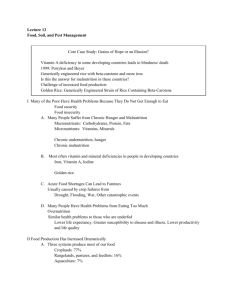Advance Journal of Food Science and Technology 5(2): 160-163, 2013
advertisement

Advance Journal of Food Science and Technology 5(2): 160-163, 2013 ISSN: 2042-4868; e-ISSN: 2042-7876 © Maxwell Scientific Organization, 2013 Submitted: September 13, 2012 Accepted: October 25, 2012 Published: February 15, 2013 Differences between Rice Cultivars in Iron Plaque Formation on Roots and Plant Lead Tolerance Xinmei Ma, Jianguo Liu and Mingxin Wang Department of Environmental and Safety Engineering, Changzhou University, Changzhou, 213164, China Abstract: The aim of this study was to understand some mechanisms on the variations between rice cultivars in lead (Pb) tolerance. Pot soil experiments were conducted with two rice cultivars under different soil Pb levels and the relationships between Pb phytotoxicity, uptake and iron plaque formation on roots were investigated. The results showed that the rice cultivar with indica consanguinity (Shanyou 63) were more sensitive to soil Pb stress than the cultivar with japonica consanguinity (Wuyunjing 7), particularly for the roots. Pb concentrations and distribution ratios in root tissues were higher for Shan you 63 than for Wuyunjing 7, but those in the plaques showed a reverse order. Fe distribution ratios in plaques were also larger for Wuyunjing 7 than for Shanyou 63, but the ratios in root tissues showed a reverse order. The results indicate that iron plaque formation on rice roots can provide a barrier to soil Pb stress in Pb-contaminated soils. The plaque will increase the sequestration of Pb on root surface, providing a means of external exclusion of soil Pb. But the function of the plaque is limited, only effective in relatively lower or moderate levels of soil Pb contamination. Keywords: Cultivars, iron plaque, lead, Oryza sativa L., tolerance pollution in agricultural soils have become increasingly serious in China (Li et al., 2000). It is toxic to many organ systems of human body (Silbergeld et al., 2000). Rice is one of the most important crops in the world and the first food in China. However, limited information is available on the relationship between plant Pb uptake, tolerance and Fe plaque formation on roots. To investigate the relations and understand some mechanisms causing the variation between rice cultivars with regard to Pb tolerance and uptake, the present research was conducted with typical rice cultivars of high or low Pb accumulation abilities based on the results of our previous studies (Liu et al., 2003). INTRODUCTION The formation of iron plaque on rice root is common due to the release of oxygen and oxidants from root in anaerobic conditions and the subsequent oxidation of ferrous to ferric iron with the precipitation of iron oxide or hydroxide in the rhizosphere. In nature, the plaque contains many metal elements, but the dominant component is Fe (Crowder and Coltman, 1993). The plaque may sequester a wide range of metals by adsorption or co-precipitation with the functional groups in iron hydroxides and thus interferes with the availability of metals in the rhizosphere. So the toxicity, uptake and distribution of heavy metals in rice plant may be influenced by iron plaque (Liu et al., 2007). On the relationships between iron plaque formation and metal uptake, some studies were conducted in wetland plants, but the results were inconsistent with each other. Some results indicated that the formation of the plaque may provide a means of attenuation and external exclusion to heavy metals (Hansel et al., 2002). But others reported no difference between the presence and absence of iron plaque in plant Cu and Zn uptake (Ye et al., 1998). Lead (Pb) is the metal pollutant with the widest distribution in the world. With rapid development in industry, agriculture and population expansion, Pb MATERIALS AND METHODS This study was performed as a pot trial at Changzhou (30°41'N, 119°50'E) in 2010. The soils for the pot experiments were collected from uncontaminated fields (0-20 cm). The properties of the soil used in this experiment are shown in Table 1. Four kilogram of soil was placed in each pot (18 cm in diameter and 20 cm in height). Pb in the form of PbCl 2 was added to the soil to obtain Pb levels of 800 and 2000 mg/kg (dry weight). Based on our previous studies (Liu et al., 2003), two rice cultivars with high (Shanyou 63) and low (Wuyunjing 7) Pb uptake abilities were used in this Corresponding Author: Jianguo Liu, Department of Environmental and Safety Engineering, Changzhou University, Changzhou, 213164, P.R. China, Tel.: 13861289063 160 Adv. J. Food Sci. Technol., 5(2): 160-163, 2013 Table 1: Selected properties of the soil used in this experiment (n = 3) Particle size (%) --------------------------------------Soil Soil type texture pH Sand Silt Clay Paddy Silty 18.4 42.7 38.9 4.71 soil loam a : Organic matter; b: Cation exchange capacity OMa (g/kg) 26.2 CECb (cmol/kg) 15.9 Total N (g/kg) 1.25 Total Fe (mg/kg) 10024.46 Total Pb (mg/kg) 34.05 Table 2: Effects of soil lead treatments on plant biomasses of two rice cultivars Root Shoot Total ------------------------------------------------------------------------------------------------------------------Cultivars Soil Pb treatments Dry weight (g/pot) RC (±%) c Dry weight (g/pot) RC (±%) Dry weight (g/pot) RC (±%) Shanyou 63 Control 4.33 9.49 13.82 800a 2.69** -37.88 6.81** -28.24 9.50** -31.26 b 2000 2.14** -50.58 5.38** -43.31 7.52** -45.59 Wuyunjing 7 Control 1.49 3.84 5.33 800 1.18** -20.81 2.85** -25.78 4.03** -24.39 2000 0.96** -35.57 2.43** -36.72 3.39** -36.40 a : The treatment with 800 mg/kg Pb in soil (dry weight); b: The treatment with 2000 mg/kg Pb in soil (dry weight); c: Relative changes under soil Pb treatment compared to the control. RC (± %) = ((weight of Pb treatment-weight of control) /weight of control) ×100; **: Significant difference between the Pb treatment and the control at the p 0.01 level Table 3: Lead concentrations in rice plants and distribution in the roots Root tissue Plaque a ------------------------------------- ------------------------------------------Cultivars Soil Pb treatments Pb concentration (µg/g) (%) Pb concentration (µg/g) (%) Shanyou 63 Control 9.17** 26.35 25.630** 73.65 800 4929.940** 93.03 369.15** 6.970 2000 14200.60 95.06 737.40** 4.940 Wuyunjing 7 Control 3.09 9.140 30.720 90.86 800 2893.200 82.51 613.23 17.49 2000 13738.21 90.24 1486.33 9.760 a : Pb concentrations in plaque is also based on root dry weights; **, *: Significant difference between the the P 0.01 , P 0.05 level, respectively experiment. The experiments were carried out in a greenhouse, with a 16-hr light period and a day/night temperature of (32-35)°C/ (23-25)°C. The pots were arranged in a randomized complete block design with three replicates. One entire plant (including shoot and root) was sampled from each pot at day 40 after seedling transplant. The plant samples were washed thoroughly with tap water and de-ionized water and then separated into roots and shoots. Iron and manganese plaque on the roots were extracted using a modified cold DithioniteCitrate-Bicarbonate (DCB) method (Liu et al., 2008). After DCB extraction, the roots and shoots were ovendried at 70°C to a constant weight. The oven-dried samples were ground with a stainless steel grinder to pass through a 100-mesh sieve. Pb and Fe concentrations of the samples were determined with AAS. Total Pb concentration of root (µg/g) 34.80 5299.090** 14938.00 33.81 3506.430 15224.54 two cultivars in the Pb concentration in shoot (µg/g) 7.3000** 163.04* 341.20 4.2800 152.62 330.03 same treatment at Wuyunjing 7. Under soil Pb treatment of 800 mg/kg, the biomass of Shan you 63 decreased by more than 30%, but the biomass of Wuyunjing 7 only decreased by about 24%. Under soil Pb treatments of 2000 mg/kg, the biomasses were reduced about 45 and 36% for Shanyou 63 and Wuyunjing 7, respectively. Under soil Pb stress, the decreasing rates of root dry weights were higher than those of shoot dry weights for Shanyou 63, but this didn’t happen for Wuyunjing7. Lead concentrations, accumulations and distributions in rice plants: The differences between the rice cultivars in plant Pb concentrations, accumulations and distributions varied with soil Pb levels (Table 3 and 4). Pb concentrations and accumulations in root tissues and the plaques of soil Pb treatments were greatly higher than those of the control, but the magnitudes of the differences were significantly higher in root tissues than in the plaques. At all Pb levels, Pb concentrations in root tissues and shoots of Shanyou 63 were higher than those of Wuyunjing 7 and the differences between the cultivars were significant (p<0.01 or 0.05) for the control and Pb treatment of 800 mg/kg (Table 3). But Pb concentrations in the plaques showed a reverse order. They were significantly higher for Wuyunjing 7 than for Shanyou 63 (p<0.01). RESULTS Growth of rice plant: The effects of soil Pb treatments on rice growth differed with rice cultivars, soil Pb levels and plant organs (Table 2). In general, Shanyou 63 were more sensitive to soil Pb stress than Wuyunjing 7. As compared to the control, root and shoot weights of the two cultivars decreased significantly (p<0.01) under soil Pb stress. However, the magnitudes of decreases were larger for Shanyou 63 than for 161 Adv. J. Food Sci. Technol., 5(2): 160-163, 2013 Table 4: Lead accumulations and distributions in different parts of the rice plants Root tissue Plaque ----------------------------------- ----------------------------------Soil Pb Pb accumulation Pb accumulation Cultivars treatments (µg/pot) (%) (µg/pot) (%) Shanyou 63 Control 39.71** 18.05 110.98** 50.45 800 13261.54** 86.31 993.01** 6.460 2000 30389.28** 89.90 1578.04* 4.670 Wuyunjing 7 Control 4.60 6.890 45.7700 68.51 800 3413.980 74.66 723.610 15.83 2000 13188.68 85.54 1426.88 9.250 Shoot -----------------------------------Pb accumulation (µg/pot) (%) 69.2800** 31.50 1110.30** 7.230 1835.66** 5.430 16.4400 24.61 434.970 9.510 801.970 5.200 Table 5: Fe concentrations and distributions in different parts of the rice plants Root tissue Plaquea ----------------------------------- ----------------------------------------------Soil Pb Fe concentration Fe concentration Cultivars treatments (µg/g) (%) (µg/g) (%) Shanyou 63 Control 804.030** 1.45 54631.84** 98.55 800 831.450** 1.59 51349.33** 98.41 2000 989.300 1.38 70850.17 98.62 Wuyunjing 7 Control 976.010 1.25 77047.67 98.75 800 1182.21 1.36 85784.53 98.64 2000 1014.11 1.31 76546.78 98.69 With regard to Pb distributions in the roots (between root tissues and the plaques), Pb distribution ratios in root tissues were much higher for soil Pb treatments (800 and 2000 mg/kg) than for the control, but the ratios in the plaques were much lower for soil Pb treatments than for the control. With the increase of soil Pb levels, Pb distribution ratios increased in root tissues, but decreased in plaques. On the differences between the rice cultivars in Pb distribution, Pb distribution ratios in root tissues of Shanyou 63 were larger than those of Wuyunjing 7. But the ratios in plaques were higher for Wuyunjing 7 than for Shanyou 63. With respect to Pb accumulations in rice plants (Table 4), Shanyou 63 was significantly higher than Wuyunjing 7 (p<0.01 or 0.05), irrespective of in root tissues, plaques or shoots. The differences between the cultivars were very enormous in root tissues and shoots. Pb distributions in different parts of rice plants varied with rice cultivars, soil Pb levels. For the control, Pb distribution ratios in different parts of rice plants were in the order: plaque>shoot>root tissue, a half or more of the Pb taken up by rice plant was stored in plaques. But for soil Pb treatments, most of the Pb was accumulated in root tissues (from about 75 to 90%). Pb distribution ratios in the plaques dropped sharply with the increase of soil Pb levels. Under soil Pb treatment of 2000 mg/kg, only less than 10% for Wuyunjing 7 and less than 5% for Shanyou 63 of Pb absorbed by rice plants was restrained in the plaque. Concerning the differences between rice cultivars in Pb distributions, the distribution ratios in root tissues were higher for Shanyou 63 than for Wuyunjing 7. But the ratios in the plaques showed a reverse order and they were larger for Wuyunjing 7 than for Shanyou 63. Total Fe concentration of root (µg/g) 55435.87** 52180.79** 71839.47 78023.68 86966.73 77560.90 Total Pb accumulation in rice plant (µg/pot) 219.9700** 15364.85** 33802.98** 66.81000 4572.560 15417.53 Fe concentration in shoot (µg/g) 245.33** 193.94** 365.03** 195.31 241.21 413.84 treatment, Fe concentrations in root tissues and plaques of Wuyunjing 7 were significantly higher than that of Shanyou 63 (p<0.01). But under 2000 mg/kg Pb treatment, the differences between the cultivars were insignificant (p>0.05). The differences between the cultivars in shoot Fe concentrations also varied with soil Pb levels. For the control, shoot Fe concentrations of Shanyou 63 were significantly (p<0.01) higher than those of Wuyunjing 7. But under 800 and 2000 mg/kg Pb treatment, shoot Fe concentration of Shanyou 63 was significantly (p<0.01) lower than that of Wuyunjing 7. On Fe distribution in rice roots, absolute majority of Fe was accumulated in plaques (more than 98.4%) and only less than 1.6% was transferred into root tissues. Fe distribution ratios in iron plaques of Wuyunjing 7 were higher than those of Shanyou 63, but the ratios in root tissues showed a reverse order, irrespective of soil Pb levels. Nevertheless, the magnitudes of the differences between the cultivars were small. DISCUSSION AND CONCLUSION Some researches showed that deposition of iron oxide plaque or coating on rice root ameliorated the toxic effects of Cu, Ni and Cu + Ni on plant growth (Greipsson, 1994). But others reported no differences in root and shoot dry weights and leaf elongation between presence and absence of the plaque, when wetland plants were exposed to Cu or Ni pollutions (Ye et al., 1997). Our present research presented that effects of soil Pb stress on rice biomasses varied largely with soil Pb levels and cultivars. In general, Shanyou 63 was more sensitive to soil Pb stress than Wuyunjing 7. Under soil Pb stress, the root and shoot weights of the rice cultivars all decreased significantly (p<0.01). However, the magnitudes of decreases were larger for Shanyou 63 than for Wuyunjing 7, particularly in root dry weights. Iron concentrations in rice plants and distribution in the roots: The differences between the rice cultivars in plant Fe concentrations varied greatly with soil Pb levels (Table 5). For the control and 800 mg/kg Pb 162 Adv. J. Food Sci. Technol., 5(2): 160-163, 2013 Under soil Pb stress, the decreasing rates of root dry weights were higher than those of shoot dry weights for Shanyou 63, but this phenomenon did not happen for Wuyunjing 7. So the root of Shanyou 63 were much more sensitive to soil Pb stress than that of Wuyunjing 7. Our research demonstrated that Fe concentrations in the plaques of Wuyunjing 7 were higher than those of Shanyou 63 and the differences were significant for most treatments (p<0.01, or <0.05). So the formations of iron plaques on rice roots may provide a barrier to soil Pb toxicity. It was reported that iron plaque on roots inhibited uptake of heavy metals by plants (Batty et al., 2000). However, Liu et al. (2008) reported that iron plaque on rice root surface is of little significance in affecting uptake and accumulation of Cd by rice plant. In our present research, there were significant or obvious differences between two rice cultivars in plant Pb concentrations and accumulations. Pb concentrations in root tissues and shoots of Shanyou 63 were higher than those of Wuyunjing 7, but Pb concentrations in plaques showed a reverse order. They were significantly higher for Wuyunjing 7 than for Shanyou 63 (p<0.01). In respect of Pb distributions in roots (between root tissues and the plaques), Pb distribution ratios increased with the increase of soil Pb levels in root tissues, but decreased with the increase of soil Pb levels in plaques. Pb distribution ratios in root tissues were in the order: Shan you 63>Wuyunjing 7. But Pb distribution ratios in plaques showed a reverse order. Meanwhile, Fe concentrations in root tissues and in plaques were significantly or obviously higher for Wuyunjing 7 than for Shanyou 63. The distribution ratios of Fe in iron plaques were also larger for Wuyunjing 7 than for Shanyou 63, but the ratios in root tissues showed a reverse order. So the formation of iron plaque can increase the sequestration of Pb on rice root surface and in the rhizosphere, providing a means of external exclusion of soil Pb stress. But this function of the plaque was limited, only effective in lower or moderate Pbcontaminated soil, because Pb distribution ratios in the plaques dropped sharply with the increase of soil Pb levels. Under soil Pb level of 2000 mg/kg, only less than 10% (or much less) of Pb taken up by rice plants was stored in the plaque. It can be concluded that the formation of iron plaque on rice root can act as a barrier to soil Pb toxicity and may be a “buffer” or a “reservoir” which can reduce Pb uptake into rice plant. But the functions of iron plaque are limited, only effective in relatively lower or moderate Pb-contaminated soil (for example less than 800 mg/kg), because Pb distribution ratios in the plaques dropped sharply with the increase of soil Pb levels. In soil Pb treatment of 2000 mg/kg, the Pb stored in iron plaque occupied only a very small proportion of the Pb taken up by rice plant, e.g., less than 10% for Wuyunjing 7 and less than 5% for Shanyou 63. ACKNOWLEDGMENT This study is supported by the National Natural Science Foundation of China (31071350, 70901035). REFERENCES Batty, L.C., A.J.M. Baker, B.D. Wheeler and C.D. Curtis, 2000. The effect of pH and plaque on the uptake of Cu and Mn in Phragmites australis (Cav.) Trin ex Steudel. Ann. Bot., 86: 647-653. Crowder, A.A. and D.W. Coltman, 1993. Formation of manganese oxide plaque on rice roots in solution culture under varying pH and manganese (Mn2+) concentration conditions. J. Plant Nutr., 16: 589-599. Greipsson, S., 1994. Effects of iron plaque on roots of rice on growth and metal concentration of seeds and plant tissues when cultivated in excess copper. Commun. Soil Sci. Plant, 25: 2761-2769. Hansel, C.M., M.J. La-Force, S. Fendorf and S. Sutton, 2002. Spatial and temporal association of as and Fe species on aquatic plant roots. Environ. Sci. Technol., 36: 1988-1994. Li, X.D., O.W.H. Wai, Y.S. Li, B.J. Coles, H. Ramsey and I. Thornton, 2000. Heavy metal distribution in sediment profiles of the Pearl River estuary. South China. Appl. Geochem., 15: 567-581. Liu, H.J., J.L. Zhang and F.S. Zhang, 2007. Role of iron plaque in Cd uptake by and translocation within rice (Oryza sativa L.) seedlings grown in solution culture. Environ. Exp. Bot., 59: 314-320. Liu, H.J., J.L. Zhang, P. Christie and F.S. Zhang, 2008. Influence of iron plaque on uptake and accumulation of Cd by rice (Oryza sativa L.) seedlings grown in soil. Sci. Total Environ., 394: 361-368. Liu, J.G., K.Q. Li, J.K. Xu, Z.J. Zhang, J.C. Yang and Q.S. Zhu, 2003. Lead toxicity: Uptake and translocation in different rice cultivars. Plant Sci., 165: 793-802. Silbergeld, E.K., M. Waalkes and J.M. Rice, 2000. Lead as a carcinogen: Experimental evidence and mechanisms of action. Am. J. Ind. Med., 38: 316-323. Ye, Z.H., A.J.M. Baker, M.H. Wong and A.J. Willis, 1997. Copper and nickel uptake: Accumulation and tolerance in Typha latifolia with and without iron plaque on the root surface. New Phytol., 136: 481-488. Ye, Z.H., A.J.M. Baker, M.H. Wong and A.J. Willis, 1998. Zinc, lead and cadmium accumulation and tolerance in Typha latifolia as affected by iron plaque on the root surface. Aqua. Bot., 61: 55-67. 163




